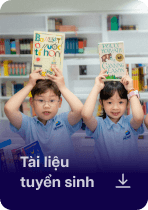The formulas, multiplication or division definitions, etc. will no longer be boring and challenging for students to memorize when it now originates from their own needs to solve real-life problems.
When it comes to division, multiplication, comparison lessons, to name a few, teachers will start with an introduction of common real-life issues instead of defining ‘What is multiplication? What is division?’ and so on. For example, when students learn how to divide by 2-digit numbers, a real-life question that how many planes can be made from 100 lego pieces, assuming that one plane requires 25 pieces, will be asked by the teacher. From this situation, students form the math question themselves, thus inspiring them to solve the question and then establishing the lesson goals about division by 2-digit numbers. The teacher is the organizer and students are those who perform the assigned tasks to solve the question and figure out operation-related definitions.
Similarly, in Grade 3’s ‘Comparing and ordering natural numbers’ lesson, Ms. Nguyen Thi Thuy also refers to the table of Covid injection numbers in 5 main provinces at the start, along with such open questions as: What information does the table tell you? Which province has the highest or lowest injection number? Once the problem and students’ solving needs are both formed, Ms. Thuy continues to guide them to discover the lesson knowledge themselves.
Thereby, learning math at TDS is more than just learning the formulas, definitions and rough numbers in student workbooks. Students are enabled to generate knowledge rather than receive it passively, understand rather than memorize, become flexible rather than rigid, grow creative rather than imitative and decide to choose the approach that helps them to ‘walk the path that the scientists have walked’.
‘The frequent practice of being placed in real-life situations, being challenged with critical thinking and being inquired promotes students’ activeness while learning and posing such questions as ‘Why this?’, ‘Why that?’ whenever they encounter a problem. Students also gradually apply the process of solving mathematical challenges, including problem identifying, data searching, solution choosing and assessment not only with paper problems but also with real-life issues when necessary,’ shared Ms. Nguyen Thi Thuy, TDS Cau Giay Math teacher.








